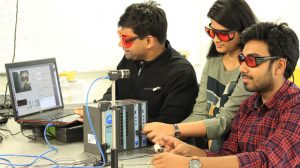 The National Science Foundation Expeditions in Computing Program has awarded $10 million to a Rice University-led team that plans to create wearable and point-of-care microscopes that use on-chip illumination and sensing to non-invasively aid in the diagnosis and monitoring of nearly 100 health conditions that today require a biopsy or blood test.
The National Science Foundation Expeditions in Computing Program has awarded $10 million to a Rice University-led team that plans to create wearable and point-of-care microscopes that use on-chip illumination and sensing to non-invasively aid in the diagnosis and monitoring of nearly 100 health conditions that today require a biopsy or blood test.
“The project will produce a platform technology for in vivo, 3-D tissue imaging, with the aim of being able to point a camera to a part of the body and see live biology below the skin without making an incision or drawing blood,” said Rice Professor Ashutosh Sabharwal, the principal investigator on the grant.
The team of 11 co-investigators from Rice, Carnegie Mellon, Harvard, MIT and Cornell is one of three groups to win new five-year grants today from the NSF’s Expeditions in Computing program. Expeditions is an interdisciplinary NSF effort that constitutes the agency’s largest single investment in computer and information science research. Rice co-investigators include Richard Baraniuk, Rebecca Richards-Kortum, and Lin Zhong. Carnegie Mellon co-investigators include Artur Dubrawski, Ioannis Gkioulekas and Rice DSP alum Aswin Sankaranarayanan. Additional co-investigators include Cornell’s Al Molnar, Harvard’s Latanya Sweeney, and MIT’s Ramesh Raskar.
Anyone who has pointed a flashlight at their palm to make their hand glow knows that light can travel through the body. But visible light scatters so much as it passes through soft tissue that it has not been useful for medical imaging. The team aims to unravel this scattered light puzzle with a technique the team calls “computational scatterography” that is a combination of machine learning algorithms and new camera designs.
“Basically, we’re trying to ‘de-scatter’ the light,” said computational imaging expert and Rice DSP faculty member Ashok Veeraraghavan, associate professor of electrical and computer engineering. “In engineering, we call this an inverse problem. Geoscientists use similar inverse techniques on seismic waves to resolve pictures of Earth’s deep interior. Our task, in some ways, is even more complicated because the amount of light scattering that takes place in even a few millimeters of tissue far exceeds other problems.”
White blood cell count (WBC) tests are an example of the project’s potential impact. In the U.S., oncologists use millions of WBC tests each week to monitor chemotherapy patients. WBC tests require a finger prick or blood draw and a laboratory, which means they can be performed only at hospitals and clinics. “Imagine a wearable device no larger than a watch that uses sensors to continuously measure white blood cell count and wirelessly communicate with the oncologist’s office,” Sabharwal said. “The patient could go about their daily life. They’d only have to go to the hospital if there was a problem.”
For more information, visit seebelowtheskin.rice.edu
